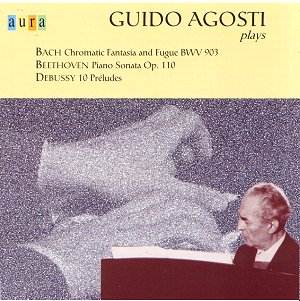J. S. BACH
Chromatic Fantasia and Fugue, BWV 903 (1)
BEETHOVEN
Sonata in A flat, op.110 (2)
DEBUSSY
Preludes, Books I and II (3)
Danseuses de Delphes; Voiles; Les collines d'Anacapri; La
sérénade interrompue; Minstrels;La puerta del vino;
"General Lavine" - excentric; La terrasse des audiences au clair de
lune; La cathédrale engloutie; C'est qu'a vu le vent d'Ouest
 Guido Agosti (pianoforte).
Guido Agosti (pianoforte).
Live recordings, Siena 1980 (1), Rome 1986 (2), Siena 1971
(3).
Aura AUR 205-2 [75' 13"]
Crotchet

The Italians enjoy a good myth as well as anyone and the country has its
fair share of performers famous for not performing. The Michelangeli legend
travelled round the world, and amongst the musical intelligentsia that count
in Italy, no native conductor is spoken of with more bated breath than Franco
Ferrara, who for health reasons had to leave the podium too soon to leave
much recorded evidence either way (he certainly became a revered teacher
of conducting). But what of Guido Agosti (1901-1989), who never entirely
left concert-giving although his platform nerves made every appearance a
torture to him and, very often, to his public as well? (He, too, became a
famous teacher). The ideal place for such a performer was surely the recording
studio but either he didn't want to or nobody thought of it. However, the
present clutch shows him on his good days (he nearly comes a complete cropper
in the trio of the Beethoven scherzo, but remember he was 85 at the time).
The provenance of the recordings is not explained and the Bach is quite awful,
a real lady's handbag recording if ever there was one, but it cannot entirely
dim the torrents of swirling semiquavers, the veritable cathedrals of glorious,
inauthentic sound which this unrepentant Busoni pupil is drawing from his
instrument.
The other recordings are not bad for what they are. In the Beethoven Agosti
plays with a noble simplicity which succeeds in avoiding the many interpretative
pitfalls with which this elusive work is littered. Maybe some other pianists
have revealed a greater spiritual depth in the Klagender Gesang,
beautifully sung though it is, but the fugues are marvellously clear.
However, it's the Debussy which makes the disc a must. Here is wonderfully
translucent sound, a truly orchestral voicing of the different strands within
the texture and, in the snappier pieces, a rhythm that makes you want to
get up and dance. These are really communicative performances and
before the last, Ce qu'a vu, Agosti treats his public to an eleven-minute
lecture-recital in which he presents the piece, in increasingly excitable
tones, as the portrayal of a shipwreck, replete with the cries of drowning
sailors. To understand this, and the interesting essay by Italy's leading
writer on pianists, Piero Rattalino, you would need to know Italian at virtually
native-speaker level (there are no translations). I thought of getting out
Gieseking for some comparisons but decided against it. Agosti is up among
the gods, and you don't compare gods.
I don't know how widely this disc is distributed outside Italy. Aura's website
is www.edimediasrl.it so
prospective buyers might seek information there.
Christopher Howells
performances

recordings
Bach zero
Beethoven, Debussy 
